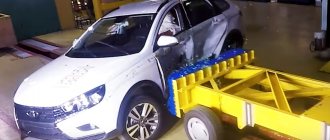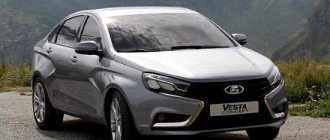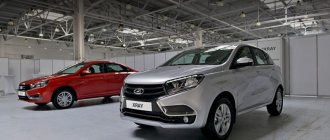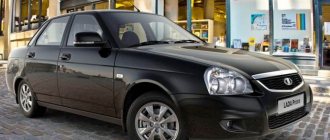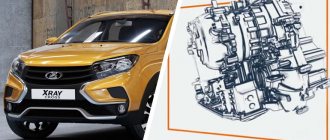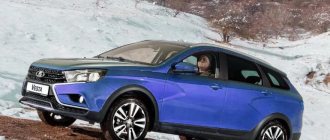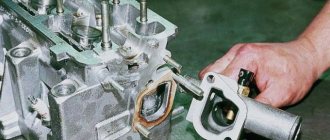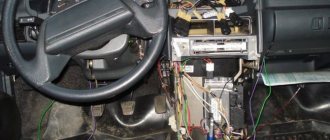Any car after the start of mass production is subjected to all kinds of crash tests. For the most part, these tests are aimed at identifying the degree of passenger safety in multidirectional collisions - frontal, side, rear. But there are also tests that simulate minor impacts, such as, for example, the Danner crash test (also called the “insurance test”). Its task is to determine the degree of damage to the car during minor impacts. Essentially, this test simulates minor accidents that often occur in city traffic. Such a crash test was carried out on the Lada X-Ray, a new crossover jointly produced by AvtoVAZ and Renault. Thanks to this test, you can roughly determine the cost of restoring a car after an accident.
The peculiarity of checking a car using the Danner method (also known as the RCAR test) comes down to the fact that the car hits an obstacle at a speed of 15 km/h. In this case, the impact should fall on the left side (40% overlap of the front part of the car), and the barrier itself should be non-deformable and located at a slope of 80 degrees. A prerequisite is also to load the test vehicle with a load weighing 50 kg.
What experts say
Today, absolutely every car enthusiast knows that the basis of the first Russian crossover was the Renault Duster and Lada C-Cross, which was introduced several years ago. There is a certain similarity between these machines, you just have to look closely at the photo.
It is worth recalling that Renault Duster was able to pass the safety tests only with a weak “C”. However, if for a foreign crossover a three on the NCAP scale is not the ultimate dream, then for Lada cars this is simply an excellent result.
How to find out the engine coolant temperature on a Lada XRAY
October 17, 2022 LadaOnline 38 361 The Lada XRAY instrument panel is a modified Renault panel. The shield consists of three wells, one of which has an on-board computer built into it. One of the features of this instrument cluster is the absence of a coolant indicator. Let's look at several ways to find out the temperature of the Lada XRAY engine.
Diagnostic adapter ELM327
You can buy an adapter (price about 400 rubles) on Aliexpress (see product catalog). We insert the adapter into the OBD-II connector (see where this connector is), connect to it via a smartphone, and display the engine temperature value on the screen using special software. By the way, you can display the temperature on the screen of the radio, which runs on Android.
On-board computer
See the review of on-board computers for Lada XRAY (prices from 2850 rubles). We install it in any place convenient for you. Such devices allow you to display not only coolant temperature readings, but also a number of other engine parameters, as well as read and erase errors.
Universal engine temperature indicator (OBD2)
Connects to the OBD-II connector and displays the coolant temperature on a small screen. Some models, for example, from ELANG LLC Togliatti, additionally allow you to read and erase errors in the engine management system. The low price (about 800 rubles) and ease of installation make this device popular among Lada XRAY owners.
Universal engine temperature indicator (sensor)
In the Aliexpress catalog you can buy a universal digital thermometer for 150 rubles. Place the display in the cabin, pull the wire with the sensor into the engine compartment (through the hole where the hood cable passes), attach the sensor to the engine cooling system hose (photo from xrayclub.ru).
Crash tests of cars from AvtoVAZ
Traditionally, the products of the Tolyatti plant demonstrate safety test results that are completely unacceptable for the European community, however, according to the manufacturer, the new Lada XRAY will be a pleasant exception in this regard. A clear confirmation of this was the information that the model received durable power elements of the cabin, while the pedals, steering wheel and engine are located more competently, which helps prevent possible injury to the driver in frontal collisions.
A video recording of the Lada Xray Cross crash test, which RG has already reported, was published on the Autoreview channel on YouTube.
The 8-minute video shows a car hitting a deformable barrier with an overlap of 40 percent from various angles. Particularly impressive was the shooting from the interior of an “all-terrain” hatchback accelerating to the target speed of 64 km/h. Unfortunately, the very moment of the collision with the obstacle, filmed from the inside, was not included in the video. It is shown only from external cameras located in the NAMI Test Center.
“The first look at the car immediately after the impact made us wary,” journalist Leonid Golovanov commented on the footage of the broken hatchback. He explained that for modern cars the discovered “small room on the windshield pillar” is uncharacteristic. The same as the sagging of the threshold on the driver's side.
It is curious that immediately after the accident, one of the testers notified the operator of the contact center of the Era-Glonass information system that the collision had occurred intentionally and the call should be cancelled. At the same time, he showed the functionality of the module installed in the car in case of accidents.
Rear air suspension Lada XRay (rear axle).
- Year of production: from 2016 to present
- For models: Lada Xray
- Installation axis: rear
- Drive: front
- Article: 01025
Suitable for VAZ-21129, HR16DE Lada XRay
Issued - 2016, 2022,2018
Benefits of use:
- Improved handling and ride quality.
- Variable ground clearance 5-10 cm.
- Side roll compensation.
- Does not require modifications.
- 1 year warranty.
A set of roll-type air springs is designed for installation on the rear axle of the Lada X-Ray. Installation is carried out instead of rear springs in standard (factory) places. Installation will not require additional modifications to the spring support areas or changes to the factory design. The kit will allow you to change the rigidity of the rear axle, significantly improving the smoothness of the ride due to the high absorption of irregularities. It becomes possible to change the clearance in the range of 5 – 10 cm.
The kit is designed taking into account climatic operating conditions in Russia. Pneumatic cushions are resistant to low temperatures, abrasives and reagents. All products come with a 1 year manufacturer's warranty. The kit also includes certificates confirming the possibility of using these products in a vehicle structure.
The kit can be equipped with 1 or 2 nipples for adjacent or independent pumping. Additionally, you can install a supply and discharge system from the passenger compartment, as well as an air intake system for inflating wheels or a pneumatic signal.
The price for the rear air suspension of the Lada Xray is indicated for
- Roll air bags - 2 pcs.
- Fastenings (a complete set for the rear axle that does not require modifications)
- Highway - 7 meters
- Pumping nipple - 1 piece
- Fitting
- Certificate
- Instructions
Additionally, it is possible to install a monitoring and control system for the air suspension from the passenger compartment.
You can buy rear axle air springs for XRay (XRay) in any region of Russia by placing an order on our website.
Testing "Lada X Ray"
One of the tasks that the Lada X Ray car was supposed to provide was guaranteed driver safety in any, even the most unfavorable situations. To achieve this, the car was equipped with effective security systems. AvtoVAZ believes that when passing the most prestigious crash test in the Euro NCAP rating, the Lada X Ray should receive three stars. A high score obtained as a result of passing this test opens the vehicle to the world market, as it is regarded by everyone as a kind of “Sign of Quality”.
The Lada X Ray is awaiting crash testing according to the RCAR and ARCAR methods.
Crash test criteria
When passing a crash test in the Euro NCAP rating, the car is subjected to tests, based on the results of which experts evaluate:
- child safety;
- driver protection;
- passenger safety;
- the danger a vehicle poses to pedestrians.
Design solutions ensuring the safety of the driver and passengers
The developers of the Lada X Ray car laid down a high level of safety at the design stage. In addition, the car has a reinforced body equipped with a number of structural elements that improve safety. These include:
- built-in roof reinforcements;
- safety bars in all doors;
- additional protective beams in bumpers;
- side body pillars.
During the development process, many parts were tested using a computer and only then embodied in metal.
Successful completion of a crash test is impossible without equipping the vehicle with passive safety systems. The use of the well-known VO platform as a layout diagram made it possible to equip the vehicle with a large number of such systems, including:
- effective system for securing child seats;
- three-point inertial seat belts for the driver and all passengers;
- belt tensioners;
- L-shaped headrests;
- automatic door unlocking upon impact;
- front and side airbags.
The car is also equipped with the most modern electronic safety systems, including ABS, EBD, BAS, ESP, TCS, etc.
Crash test methods
In world practice, the term “crash test” is used to refer to testing vehicles for safety. These tests simulate different types of road traffic accidents in order to find out what kind of damage those involved can suffer. In this case, instead of living people, special mannequins are used. There are a large number of different types of crash tests, but the most common are tests carried out using the following methods:
- Euro NCAP methodology. The modern, most prestigious type of comprehensive testing, which includes:
- frontal collision at a speed of 64 km/h with a deformable barrier, with the impact occurring at 40% of the width of the front of the vehicle (driver's side);
- side collision at a speed of 55 km/h with a deformable barrier;
- head-on collision at a speed of 55 km/h with a rigid barrier.
Repair at the service center. Price
The service center usually replaces all damaged elements. And this, in turn, affects the cost of repairs, as well as time, because you often have to wait for the delivery of spare parts. From the damage listed above, you can understand which elements will need to be replaced. We will immediately indicate the cost of each part. So, to restore a car you will need:
- Hood ($185-210);
- Headlights 2 pcs. ($625-710);
- Left wing ($75-90);
- Cross beam ($210-250);
- Upper crossbar ($150-175);
- Front spar ($170-$190);
- Bumper ($165-280);
- Radiator grille ($20-25).
In general, you will have to spend from $1,600 to $1,930 on spare parts (it all depends on the suppliers). You will also have to pay the service for restoration - replacing damaged elements, editing some of them, painting work. The total cost of the work will cost about $850. In total, restoring a Lada X-Ray to its original condition in the event of such a minor collision will cost $2,450-$2,780 in service. And this is with the price of the car itself being $10,380-$13,850. That is, for restoration you will have to pay almost a quarter of the cost of the crossover.
Assessment of the body exterior and interior
External parameters do not in any way affect the functionality and performance of the car, but they also play a significant role for many car enthusiasts. It is much more pleasant to drive a beautiful vehicle - otherwise the developers would not strive so hard for the ideal design.
Pastushenko immediately noted that there is no arguing about tastes. An objective assessment of a model from the point of view of its visual qualities is quite shaky ground, since it is ultimately built on a subjective opinion (the result cannot be expressed in a numerical equivalent)
However, even the presenter could not help but draw his attention to some aesthetic nuances (they can be seen in more detail in the proposed photos)
Firstly, the combination of body sizes and wheels was considered not the best choice of designers. The body is not only quite large in fact, but also extremely massive visually - wheels with fifteen-inch discs look somewhat grotesque and ridiculous in this model, practically getting lost against the backdrop of the powerful base
However, this fact is viewed neutrally or even positively by some car enthusiasts, so it is not worth focusing on.
This is interesting: Renault Logan test drive video
Secondly, the element of the body's relief, covering the central pillar, actually somewhat resembles a dent. This is especially noticeable with glossy body paint. This feature is absent in concept No. 1, as critics point out when they express angry reviews about the “ruined” design of concept No. 2, on the basis of which the production car was created.
However, the quality of execution itself inspires respect. The body is galvanized, so it will not be subject to corrosion, of course, until the first damage to certain parts. The colors available for choice are also pleasing to the eye - Maxim especially liked the bright orange “Fresh” color, available for buyers of top-end Lada XRay trim levels.
The interior of the cabin did not raise any questions. It is made extremely competently - you can feel the work of an experienced designer who knows his business, and the style and type of the car’s interior space are noticeable.
For comparison
Volkswagen Polo. The hood, both headlights, bumper, crossbar with crushed elements, plastic radiator mounting box and air duct are damaged.
Hyundai Solaris. The bumper was cracked, the hood and fender were slightly dented, the headlight and fog lamp housing were destroyed, the front beam and the end of the left side member were damaged
Chevrolet Cobalt. The bumper cover is torn, both headlights are damaged, the front panel, crossbar, hood and left fender are deformed
Peugeot 408. The crossbar and replacement mounts of the left headlight are damaged, the bumper trim is slightly damaged
Renault Sandero. The front beam, engine subframe, front part of the left side member, top panel, front left fender and engine compartment mudguard were deformed. The left headlight is broken, the edge of the hood is dented, the front bumper is torn, the radiator mount is broken
Lada Granta. The radiator frame is crushed and torn, the hood, headlight, both wings, and spar are damaged.
Nissan Almera. The bumper lining was damaged, both headlights were damaged, the front panel, crossbar, side member, subframe, hood and left fender were deformed.
Skoda Rapid. The edge of the hood is jammed, the headlight, bumper trim, crossbar with crushed elements, radiator mounting screen, left fender, fog lamp are damaged.
Geely Emgrand. The hood, fender, amplifier and bumper trim, headlight, and transmission radiator were damaged. The front body panel, side member and mudguard of the engine compartment were deformed
Lada Vesta. The hood, cross beam with crushed elements, bumper trim, headlight, and radiator mount were damaged. The left fender was slightly damaged, the plastic bumper reinforcements and the receiver air duct were cracked
About security
Lada Largus has become popular among motorists. Not the least role in this was played by numerous borrowings of ideas used on the French station wagon, produced until 2006. In the minimum configuration, as well as in the “norm” version, in addition to audio preparation and a standard 4-cylinder engine, the manufacturer offered one front airbag for the driver, which was not bad at that time.
As for the materials used in production, they are standard for modern automotive industry. Their quality, traditionally for domestic manufacturers, is not the highest in order to reduce the cost. Many motorists, especially the old generation, complain that previously the metal of the body was much thicker, which is why cars lasted a long time. For example, on GAZ cars (the legendary Volga) the thickness was up to two millimeters, but now it rarely reaches one millimeter even on the bottom. For example, on Largus the bottom is 0.9 mm, and the body parts are from 0.6 to 0.8 mm.
The modern generation may assume that this was done to reduce the weight of the car: adding lighter and stronger materials instead of heavy metal. On foreign cars, especially class C and higher, this may be the case. But this does not apply to the budget class, to which Largus belongs. Therefore, there is no need to talk about the safety of the materials used by the manufacturer. But, on the other hand, car owners are ready to neglect safety by getting a cheaper and more practical car for everyday life.
Still, Largus, despite its low cost, boasts high-quality steel, which makes up the strength structure of the body elements and thereby ensures passive safety. Body panels and plastic (soft or hard) do not affect safety in any way. All this is primarily created for beauty and serves to give a certain individual style.
